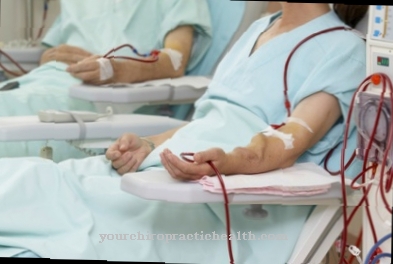The active substance Cisplatin belongs to the cytostatics. It is used to treat malignant cancers.
What is cisplatin?
For cisplatin (cis-diamminedichloridoplatinum) is a cytostatic that inhibits the growth of cancer cells. The drug forms an inorganic heavy metal compound containing platinum and has a complex-bound platinum atom. Cisplatin is in the form of orange-yellow crystals or a yellow powder. It is difficult to dissolve in water.
The cytostatic effects of platinum complexes were discovered by chance in the 1960s. The American chemist Barnett Rosenberg (1926-2009) investigated the effect of alternating current on the bacterial species Escherichia coli. For this purpose Rosenberg used platinum electrodes. The experiment revealed cell growth inhibiting effects.
Research showed that this property was not caused by the alternating current, but rather due to the complex compound cis-diammine tetrachloridoplatinum (IV), which came about through the platinum electrodes. Further tests confirmed the growth-inhibiting effect.
It was not until 1974 that cisplatin was used for the first time in the treatment of cancer. In a study at the University Hospital of the US state of Indiana, the active ingredient was used to treat testicular cancer. In the further course the agent showed positive treatment successes without a relapse of the cancerous disease. In Germany, cisplatin was used under the product name Cis-GRY®. In addition, numerous generics made it onto the market.
Pharmacological effect
Cisplatin has the property of inhibiting the production of genetic material such as DNA. During this process, the drug attaches itself randomly to all of the DNA building blocks and senselessly links the individual strands with one another. It is believed that the mechanism of action is independent of the life cycle of the cells. To a lesser extent, cisplatin also hampers the production of proteins that are of vital importance to the cell.
Due to the pointless networking of the DNA strands, the DNA information can only be read incorrectly or even not at all. In this way, cisplatin inhibits the division of cells, which ultimately leads to their destruction.
The administration of cisplatin takes place intravenously. When the substance is distributed, the blood-brain barrier is also overcome. The organs in which the cytostatic agent preferentially accumulates include the intestines, liver, kidneys and male testes. The excretion of cisplatin and its metabolic products occurs primarily in the urine. The bile excretes the rest.
Medical application & use
As a single preparation or together with other cytostatics, cisplatin is administered for the treatment of advanced cancer diseases. This also applies if the tumor has already metastasized (daughter tumors).
The most common areas of application include prostate cancer, testicular cancer, bladder cancer, esophageal cancer, head and neck cancer, cervical cancer, ovarian cancer, lung cancer, black skin cancer, squamous cell carcinoma, pancreatic cancer and an osteosarcoma, which is a malignant bone tumor.
Cisplatin is administered through an infusion. In most cases there is a combination with other chemotherapy drugs. The dosage is usually 15 to 20 milligrams of cisplatin per day per square meter of body surface. Higher dosages, such as 80 to 120 mg per square meter of body surface, are also possible. In principle, cisplatin treatment for children can be carried out. The doctor adjusts the dose to the child's body.
You can find your medication here
➔ Medicines for smoking cessationRisks & side effects
The use of cisplatin is not free from side effects. The cytostatic drug often causes diarrhea, nausea and vomiting. This unpleasant side effect can, however, be brought under control relatively well by the administration of modern antiemetics. Cisplatin also has a negative effect on the cells of organs such as the kidneys. These side effects can be partially counteracted by the cytoprotector amifostine.
Other common side effects are changes in the blood count such as a lack of white blood cells and platelets, anemia (anemia), sodium deficiency, fever, excess uric acid, palpitations, heart rhythm disturbances, a slow heartbeat, blood poisoning (sepsis), breathing difficulties and inflammation of the blood vessels the injection site.
Occasionally, hypersensitivity reactions such as reddened skin, hives, rashes or itching, hearing disorders, painful swellings in the chest, ovulation disorders, malformations of male sperm, magnesium deficiency and metal deposits in the gums can occur. In the elderly and children, the hearing impairment can take on considerable proportions.
Because cisplatin can cause severe kidney problems, the treating physician encourages the urine to be excreted. For this purpose, he adds two liters of a suitable solution and a dehydrating preparation such as mannitol to the active ingredient.
Cisplatin must not be administered if the patient is hypersensitive to the active ingredient or other platinum-containing compounds. The same applies to kidney dysfunction, dehydration of the body, pre-existing hearing damage and bone marrow dysfunction. If the patient also suffers from disorders of his nerve function, the doctor must carefully decide between the risk and benefit of cisplatin therapy.
Under no circumstances should the cytostatic drug be administered during pregnancy as it can be fatal to the unborn child. There is also a risk of developing cancer later on in the child. For this reason, strict contraceptive measures should be taken during treatment, which applies to both female and male patients.
In addition, cisplatin can lead to permanent infertility. Female patients must refrain from breastfeeding their child during therapy, as the active ingredient can pass into breast milk.













.jpg)

.jpg)
.jpg)











.jpg)